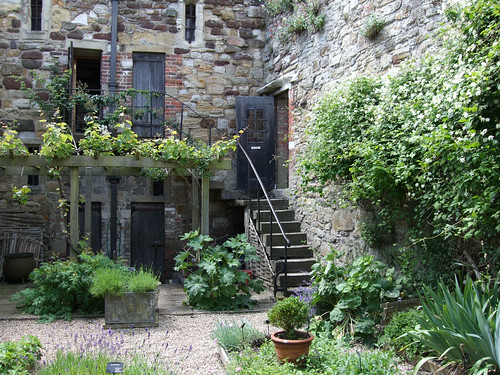The mythology of plants and herbs

If you look in your kitchen cupboard it is very likely that you will find small jars or packets of herbs which you probably add to food to give it extra flavouring. For many thousands of years humans have used herbs or plant extracts for many different purposes both practical and symbolical. Today we tend to use the herbs for mainly food flavourings or for medicinal purposes but we sometimes forget just how important these natural foods and remedies were in the everyday life of our ancestors. We know from archaeological evidence that from the dawn of man herbs were in everyday use so it is not surprising that over the centuries a huge mythology has formed about certain plants and herbs which give us an insight into how they were viewed and used in the past.
The herbs we use today come from many parts of the world. For example we know a lot about the herbs used in Ancient India and Ancient China through a famous Arabic doctor called Avicenna who studied ancient writings. We also know that in the middle Ages across Europe monks grew many herbs in the monastery gardens and used many of them to make herbal drinks as well as medicines. In Germany for example an abbess known as Hildegarde of Bingen was a famous herbalist who treated the sick with herbs as the Chinese still do today.
In the 15th and 16th centuries pilgrims took herbs with them to America that they used in England. Then, over time, herbs native to America came to Europe and other parts of the world. Trade in herbs though started much earlier than this with Phoenicians and Romans buying and selling herbs from all over the world.
In Britain a herbalist Nicholas Culpepper published a book in 1653 to help ordinary people make their own herbal remedies instead of paying for expensive ones from doctors. The book called ‘The Complete Herbal’ is still very popular even today.
Today we are able to trace the origins of many herbs and plants which gives us an insight into not just how important they were but also the myths that surrounded them. Here are a few examples.
Basil – Today Basil is in common use as a culinary herb. There are many stories about the origins of Basil and one of the more interesting theories is that the name originates from a mythical beast known as a ‘Basilisk’. The Basilisk was a sort of giant lizard, much like the smaller bearded lizards of today (still called dragons in some cultures) and in mythological stories it was believed that a single look from the eye of a Basilisk was enough to kill a man. Scorpions have also been associated with Basil and it was even thought that eating too much Basil could result in scorpions inside the brain!
Bay Laurel – One of the favourite Greek myths pertaining to Bay Laurel is that Apollo was teasing Cupid about his tiny arrows so Cupid shot one arrow of love into his heart. Daphne, a nymph, was standing close by watching the two gods so Cupid shot another arrow into her heart but this time one of repulsion. Apollo then saw Daphne and fell madly in love but she became frightened and started to run away from him. Apollo though was too fast for her so she cried out for help to her father Peneus who magically turned her into a Bay Laurel tree to save her from Apollo’s attentions. Apollo grabbed the tree and flung his arms around it crying, “My love, my love, I shall love you forever and I will wear your leaves as a crown to remember you” Supposedly this is the reason that to this day Bay Laurel wreaths are used as a sign of victory and honour. Today the Bay leaf is also commonly used in many meat dishes and soups.
Borage – According to Greek historians Borage was the famous ‘nepentha’ mentioned by Homer – a herb which was drunk after battle steeped in wine in order to bring about complete forgetfulness. There is an old saying “Borage is for Courage”. Borage has been used as a pot herb or in cooling drinks and the flowers can be candied or frozen in ice cubes.
Fennel – Fennel was held in reverence by early man because in mythology Prometheus brought fire to man in its hollow stem. It was and still is used as a vegetable and also used as an aid to digestion.
Garlic – In Ancient times Garlic was always placed at crossroads as a supper for the goddess Hecate. Homer tells us that one of the other virtues of garlic is that its properties also saved Ulysses from being turned into a pig by a wicked witch. Garlic has been popular for centuries and is today commonly used as a flavour enhancer for meats. It also has proven medicinal properties as it contains a natural antiseptic and antibiotics. It is also used today used as a stimulant, diuretic and expectorant as well as being used in healing ointments.
Mistletoe – Mistletoe has a long history as a magical plant. It was considered the “Golden Bough” which opened the world of the dead to mortals. To the primitive mind, mistletoe represented the opposite of death and was therefore the emblem of life itself. It was also thought to be a panacea to cure all ills. It was said that Asclepus, the son of Apollo, learned the arts of healing and was therefore considered the father of medicine. He cured many Greeks with mistletoe and legend has it that he was first shown mistletoe by a serpent in a tomb.
Mulberry – Mulberry berries were dedicated to the goddess Minerva and have always been closely associated myths about love. They were also a common delicacy at ancient feasts. In Shakespeare’s ‘A Midsummer night’s dream’ for example Pyramus and Thisbe were in love but were forbidden to marry by their parents. They planned a midnight meeting under a mulberry tree and ended up killing themselves for the sake of love. In mythology their mingled blood was then absorbed by the tree and the berries, which had been white, were turned deep red as they have remained to this day. Mulberries can be eaten raw but more popularly they are these days made into jams or wine.
Narcissus – The word, narcissism, meaning ‘to love oneself’ derives from the myth of a beautiful youth named Narcissus. It is said that he saw his own image reflected in a pool of water and fell in love with it. Although he tried in vain to embrace the image it always eluded him and he became so grief stricken that he starved himself to death and on the spot where he died a beautiful flower bloomed.
Nightshade – In past times it was always believed that the devil himself lived inside this deadly poisonous plant which is also, ironically, a valuable medicine. Its botanical Latin name derives from one of the ‘three fates’, Atropos, who in mythology cut the thread of life and this alludes to its poisonous attributes. Today eye specialists use Atropine to dilate the eyes and it is also sometimes used as an antispasmodic.
Parsley – Parsley is said to have sprung from the blood of the Greek hero Archemorus, the forerunner of death. This herb was dedicated to Persephone, goddess of the underworld, and was used in funeral rites as it was considered the herb of the dead. Today Parsley is widely used as a culinary herb and is also used medicinally. It is also a diuretic.
Poppy – Somnus the god of sleep was always crowned with poppies or is depicted lying surrounded by them. Also in popular mythology Ceres, the goddess of corn, wore a crown of grain interwoven with poppies which were considered sacred. Poppies are often called cornflowers in many European countries. The seeds can be used in cakes and the juice removed from the head is used medicinally for pain.
Rosemary – Rosemary has always had a reputation for strengthening the memory. In mythology the ‘Muses’ were the nine daughters of Jupiter and Mnemosyne (Memory). They presided over song and prompted the memory. The Muses are often pictured with rosemary in their hands and Minerva, the goddess of knowledge, is also associated with this herb. It was often used at both weddings and funerals as it sometimes is today. Rosemary is a versatile herb used widely for flavouring meat dishes, in flower displays as well as for medicinal purposes.
Thyme – ‘Thymus’ comes from the Greek word meaning courage. This herb was known to the Ancients because it is a herb loved by bees which convert it into honey which was in turn loved by the gods. It was used as an aromatic herb and also rubbed on tables to clean them for food. Thyme was also used internally and externally as an antiseptic. “To smell of thyme” was an expression of praise. It was also used to preserve meat.
Yarrow – Achilles, the great warrior in the ten year Trojan War staunched the bleeding wounds of his soldiers with Yarrow. He also tried to use Yarrow to stop the bleeding wound in his heel that became known as the “Achilles tendon”. Yarrow was called the military herb by the Ancients. Today Yarrow is used as hops in beer, as snuff, and as an antiseptic.
So next time you find herbs growing in your garden or add them to your food stop for a moment and reflect on just how important these extraordinary natural products are and how important they always were to our ancestors.





